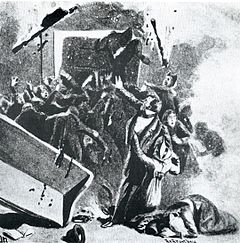
Grue is a municipality in Innlandet county, Norway. It is located in the traditional district of Solør. The administrative centre of the municipality is the village of Kirkenær. Other villages in the municipality include Bergesida, Grinder, Namnå, Risberget, Rotberget, Skasenden, and Svullrya.

Lom Stave Church is a parish church of the Church of Norway in Lom municipality in Innlandet county, Norway. It is located in the village of Fossbergom in the traditional district of Gudbrandsdal. It is the church for the Lom parish which is part of the Nord-Gudbrandsdal prosti (deanery) in the Diocese of Hamar. The brown, wooden stave church was built around the year 1170 using plans drawn up by an unknown architect. The church seats about 350 people.

Hoff Church is a parish church of the Church of Norway in Østre Toten Municipality in Innlandet county, Norway. It is located in the village of Kraby, just east of the municipal centre of Lena. It is the church for the Hoff parish which is part of the Toten prosti (deanery) in the Diocese of Hamar. The white, stone church was built in a long church design during the 12th century using plans drawn up by an unknown architect. The church seats about 332 people.

Kirkenær is the administrative centre of Grue Municipality in Innlandet county, Norway. The village is located on the eastern shore of the river Glomma. The village of Namnå lies about 4 kilometres (2.5 mi) to the north and the village of Grinder lies about 5.5 kilometres (3.4 mi) to the south.

Skien Church is a parish church of the Church of Norway in Skien Municipality in Telemark county, Norway. It is located in the town of Skien. It is the church for the Skien parish which is part of the Skien prosti (deanery) in the Diocese of Agder og Telemark. The red brick church was built in a cruciform design in 1894 using plans drawn up by the architect Hagbarth Martin Schytte-Berg. The church seats about 1,050 people.
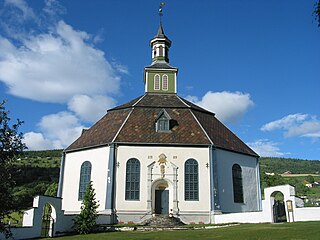
Sør-Fron Church is a parish church of the Church of Norway in Sør-Fron Municipality in Innlandet county, Norway. It is located in the village of Hundorp. It is the church for the Sør-Fron parish which is part of the Sør-Gudbrandsdal prosti (deanery) in the Diocese of Hamar. The white, stone church was built in an octagonal design in 1792 using plans drawn up by the architect Svend Aspaas. The church seats about 750 people.
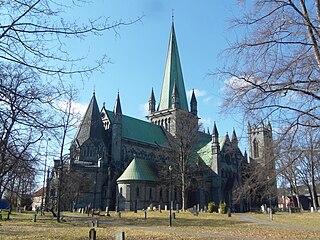
Church building in Norway began when Christianity was established there around the year 1000. The first buildings may have been post churches erected in the 10th or 11th century, but the evidence is inconclusive. For instance under Urnes Stave Church and Lom Stave Church there are traces of older post churches. Post churches were later replaced by the more durable stave churches. About 1,300 churches were built during the 12th and 13th centuries in what was Norway's first building boom. A total of about 3,000 churches have been built in Norway, although nearly half of them have perished. From 1620 systematic records and accounts were kept although sources prior to 1620 are fragmented. Evidence about early and medieval churches is partly archaeological. The "long church" is the most common type of church in Norway. There are about 1620 buildings recognized as churches affiliated with the Church of Norway. In addition, there are a number of gospel halls belonging to the lay movement affiliated with the Church of Norway as well as churches belonging to other Christian bodies. Until the 20th century, most churches were built from wood. 220 buildings are protected by law, and an additional 765 are listed as valuable cultural heritage.
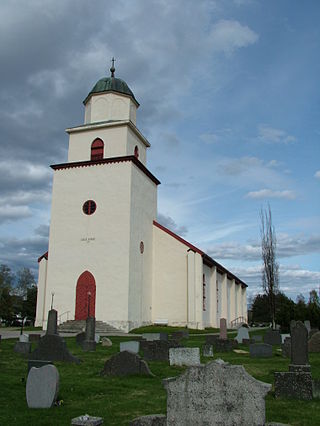
Grue Church is a parish church of the Church of Norway in Grue Municipality in Innlandet county, Norway. It is located in the village of Kirkenær. It is the church for the Grue parish which is part of the Solør, Vinger og Odal prosti (deanery) in the Diocese of Hamar. The white, stone church was built in a long church design in 1828 using plans drawn up by the architect Hans Linstow. The church seats about 500 people.
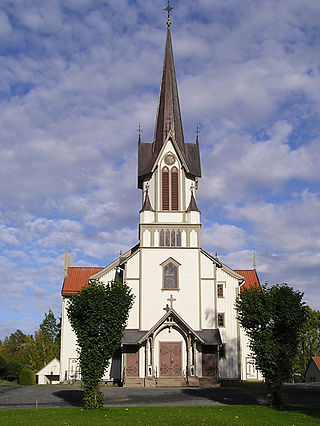
Bamble Church is a parish church of the Church of Norway in Bamble Municipality in Telemark county, Norway. It is located in the village of Bamble. It is one of the churches for the Bamble og Herre parish which is part of the Bamble prosti (deanery) in the Diocese of Agder og Telemark. The white, wooden church was built in a long church design in 1845 using plans drawn up by the architect Gustav Adolph Lammers. The church seats about 400 people.

Grue Finnskog Church is a parish church of the Church of Norway in Grue Municipality in Innlandet county, Norway. It is located in the village of Svullrya. It is the church for the Grue Finnskog parish which is part of the Solør, Vinger og Odal prosti (deanery) in the Diocese of Hamar. The white, wooden church was built in a long church design in 1886 using plans drawn up by the architect Niels Stockfleth Darre Eckhoff and it was significantly rebuilt in 1950 by the architect Ola B. Aasness. The church seats about 340 people.

Veum Church is a parish church of the Church of Norway in Fyresdal Municipality in Telemark county, Norway. It is located in the village of Øyane. It is one of the two churches for the Fyresdal parish which is part of the Øvre Telemark prosti (deanery) in the Diocese of Agder og Telemark. The white, wooden church was built in a long church design in 1863 using plans drawn up by the architect Christian Grosch. The church seats about 180 people.
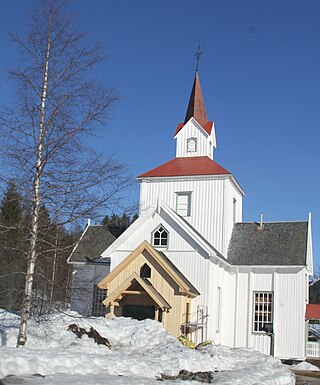
Hjartdal Church is a parish church of the Church of Norway in Hjartdal Municipality in Telemark county, Norway. It is located in the village of Hjartdal. It is one of the churches in the Hjartdal parish which is part of the Øvre Telemark prosti (deanery) in the Diocese of Agder og Telemark. The white, wooden church was built in a cruciform design in 1812 using plans drawn up by the architect Jarand Aasmundson Rønjom. The church seats about 220 people.

Flåbygd Church is a parish church of the Church of Norway in Nome Municipality in Telemark county, Norway. It is located in the village of Flåbygd. It is one of the churches in the Lunde og Flåbygd parish which is part of the Øvre Telemark prosti (deanery) in the Diocese of Agder og Telemark. The white, wooden church was built in a cruciform design in 1822 using plans drawn up by the architect Gunnar Knutson Saga. The church seats about 180 people.
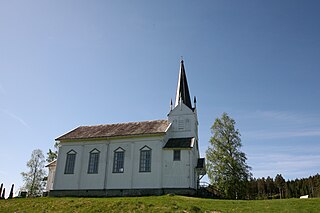
Lisleherad Church is a parish church of the Church of Norway in Notodden Municipality in Telemark county, Norway. It is located in the village of Landsverk. It is the church for the Lisleherad parish which is part of the Øvre Telemark prosti (deanery) in the Diocese of Agder og Telemark. The white, wooden church was built in a long church design in 1873 using plans drawn up by the architect Jacob Wilhelm Nordan. The church seats about 140 people.

Rjukan Church is a parish church of the Church of Norway in Tinn Municipality in Telemark county, Norway. It is located in the town of Rjukan. It is one of the churches for the Rjukan parish which is part of the Øvre Telemark prosti (deanery) in the Diocese of Agder og Telemark. The brown, stone church was built in a cruciform design in 1915 using plans drawn up by the architects Carl Berner and Johan Berner. The church seats about 350 people.

Drangedal Church is a parish church of the Church of Norway in Drangedal Municipality in Telemark county, Norway. It is located in the village of Prestestranda. It is the church for the Drangedal parish which is part of the Bamble prosti (deanery) in the Diocese of Agder og Telemark. The white, wooden church was built in a cruciform design in 1775 using plans drawn up by an unknown architect. The church seats about 300 people.

Tørdal Church is a parish church of the Church of Norway in Drangedal Municipality in Telemark county, Norway. It is located in the village of Bø. It is the church for the Tørdal parish which is part of the Bamble prosti (deanery) in the Diocese of Agder og Telemark. The white, wooden church was built in a cruciform design in 1809 using plans drawn up by the architect K. Johnsen Bøe. The church seats about 300 people.

Sannidal Church is a parish church of the Church of Norway in Kragerø Municipality in Telemark county, Norway. It is located in the village of Sannidal. It is the church for the Sannidal parish which is part of the Bamble prosti (deanery) in the Diocese of Agder og Telemark. The white, wooden church was built in a cruciform design in 1772 using plans drawn up by an unknown architect. The church seats about 330 people.
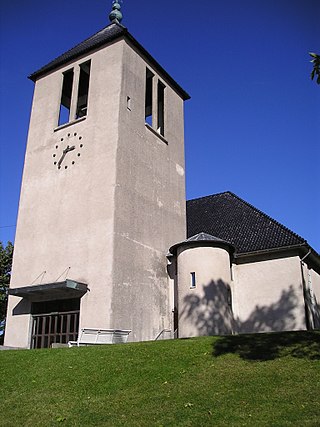
Brevik Church is a parish church of the Church of Norway in Porsgrunn Municipality in Telemark county, Norway. It is located in the village of Brevik. It is one of the churches for the Eidanger parish which is part of the Skien prosti (deanery) in the Diocese of Agder og Telemark. The grey, concrete church was built in a rectangular design in 1963 using plans drawn up by the architect Gudolf Blakstad. The church seats about 450 people.

Hurum Church is a medieval stone church in Hurum, Norway. It was constructed in the 12th century. The church was damaged by fire in 1686, and rebuilt with a baroque interior. Next to the church, the Huitfeldt-family built a wooden funeral chapel in the second half of the 17th century. A new stone chapel was built in 1750, and contains the remains of the naval commander Iver Huitfeldt.
